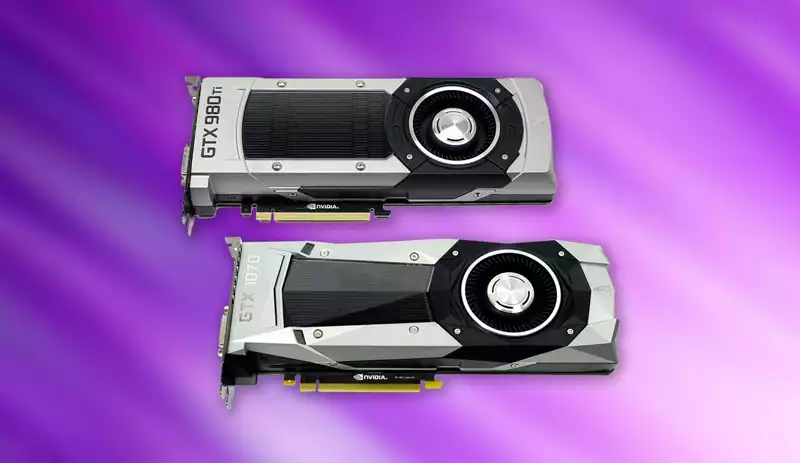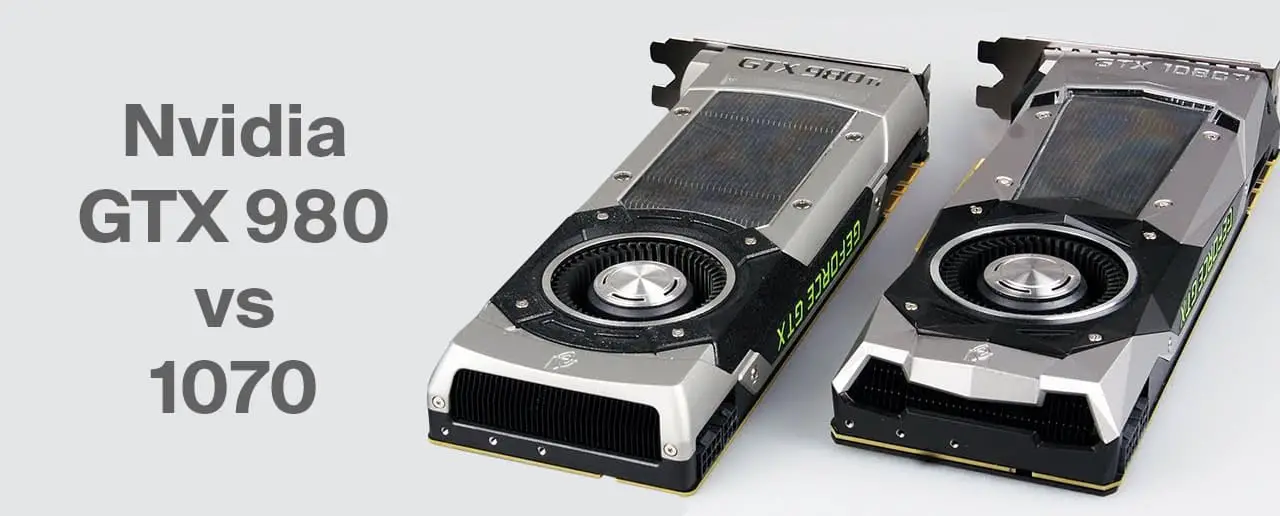You can also be interested in these:
- Nvidia RTX 3090 vs RTX 3090 Ti: The not-so-obvious conclusion
- NVIDIA GeForce GT 720 review
- NVIDIA GeForce GTX 1050 Ti Max-Q review
- NVIDIA Quadro FX 3800 review
Nvidia GPUs go way past parallel processing and bring forth new capabilities and features with the GTX 980 vs 1070. The NVIDIA GeForce GTX 980 and GTX 1070 are graphic processing units (GPUs) that were originally designed for parallel processing, but are now used for a multitude of functions, such as video rendering and graphic capabilities.

The wide range of performances in gaming also extends to the popular use in artificial intelligence and creative production. GPUs are extremely flexible and work to accelerate the rendering of all 3-D graphics. Today’s graphic processing units have enhanced properties, allowing programmers to become more flexible and innovative during creative concepts. The comparison of GTX 980 vs 1070 shows consumers very noticeable differences.
The GTX 980 delivers higher second performance and intentional design to avoid FPS loss
The GTX 980 reaches 50 to 60 frames per second during visual effects. It accomplishes this without antialiasing, turning down shadows, or creating occlusion. Before the GeForce 10 series ever came into production, the 980 was the top marketed Maxwell-based product for high-end gaming. The Maxwell architecture delivered higher second for second performances than other large GPU sellers, such as Kepler. When analyzing the teamwork between the GTX 980 and an Intel Core i7-4770K running at a speed of 3.50GHz, the 980 has less than 8% of PC bottleneck in gameplay.
The GTX 980 structurally contributes to a properly balanced PC, creating components that achieve what they were made to do. All sets of components balance out and create a proportionate utilization for a better gaming experience. The GTX 980 is intentionally designed to avoid FPS loss, meaning that frame rates stay consistent over time despite CPU temperature or other control issues like throttling. The GTX 980 is part of the GeForce 900 series and was the last to support analog video output through DVI-I. NVIDIA appeared to be dropping analog options during this release because it planned to go forward with higher technology.
GTX 980 vs 1070 comparison proves the 100 series takes the lead
When it comes to the GTX 980 vs 1070, the price does jump for an ultra-quality GPU that clearly surpasses NVIDIA’s older series. Both GPUs share a lack of memory-related bottlenecks and are able to speed up processing. The major difference is that the GTX 1080’s specifications surpass all in the 900 series, and is the high-end selection of graphics cards. The 1070 increases the FPS by 2% and beats the entire 900 series with significantly higher clock speeds and more memory. The GTX 980 vs 1070 stats show that the 1070 has 8 GB RAM compared to the GTX 970 ‘s 4 GB RAM video memory.

Gameplay performance is exceptional in comparison to the GTX 980, with a higher pixel rate of 96.4 pixels. The 980’s pixel rate is 77.8 pixels. The motion movement on the 1070 has a significantly higher turbo clock speed and better floating-point performance. Users will notice a smoother experience of both clarity and speed, creating a gaming experience without lag or memory space issues. The GTX 980 vs 1070 stats offer major differences in frame rate, too. The frame rate within the 980 is 81.15fps versus the 1070’s 88.5fps. The GTX 1070’s performance regularly delivers great frame rate increases over the GTX 970 and it really justifies the pricing. Gamers will find that the extra cost for any selection in the 100 series is going to reward the user with less input latency, screen tearing, and stuttering graphics during gaming and video playback.
The entire 100 series dumped analog support by following Intel and AMD’s futuristic lead. When looking at the scope of the GTX 980 vs 1070, analog features represent which GPU is ahead of its time. The GTX 1070 is upgraded in every specification to the point where getting rid of analog support only made sense. The NVIDIA line made its most major change with the 1070 by removing the DVI port with wiring for analog signals, also known as DVI-I.
The GTX 1080 only has a digital DVI-D port. Naturally, this means that the reference card does not have the support for VGA. VGA stands for Video Graphics Array. The VGA cable is a device meant to send video signals back and forth as a link between computers and monitors. It is also able to send signals between the computer and the television screen. The company doesn’t seem to have any plans to bring back VGA for their future series, rendering it mostly useless. Perhaps the future of GPUs finally put an end to an old-school gaming variable that started in 1987.
Similar features of the GTX 980 vs 1070 allow user preference as the deciding factor
The GTX 980 vs 1070 GPUs do have important components in common. They are both meant to speed up processing, store 3-D data, illuminate graphics and textures, and focus on intermediate data for image generation. On paper, the GTX 1070 obviously beats the 980 and any other product in the 900 series, but the price increase may not be worth the specs depending on user activity. The choice of gameplay does not automatically point to one GPU over another.
Choosing between these two models heavily relies on the user preference in regard to the amount of pixels or on-board memory required. The GTX 980 is a more affordable choice for consumers who know that their gameplay does not surpass certain specifications. Both GPUs have higher bandwidths than system RAM, and more bandwidth allows all display images to reach their highest resolution potential.
NVIDIA ’s GPUs have never been represented as unaffordable, luxury technology. The company has successfully created a reputable brand that has always celebrated mid-range prices. In regards to the competition of GTX 980 vs 1070 GPUs, both provide stunning performances that challenge higher-end graphics technologies. Users can analyze their gameplay to see which GPU is more realistic for their lifestyles.
On paper, the GTX 1070 upsells every previous product series, but both provide brilliant visual effects and textured scenes with advanced lighting and shadowing techniques. Neither option has any major drawback that will be detrimental to gameplay. The user’s decision-maker should come down to price and personal requirements. Game design engineers and program developers outside of the gaming world are beginning to embrace the power of GPUs to drastically push forward high-performance computing.
A few relevant references:
More stories like this
- Nvidia RTX 3090 vs RTX 3090 Ti: The not-so-obvious conclusion
- NVIDIA GeForce GT 720 review
- NVIDIA GeForce GTX 1050 Ti Max-Q review
- NVIDIA Quadro FX 3800 review
- All About the Ada Lovelace Architecture technology of the GeForce RTX 40 Series
- Nvidia GeForce RTX 4090 full review